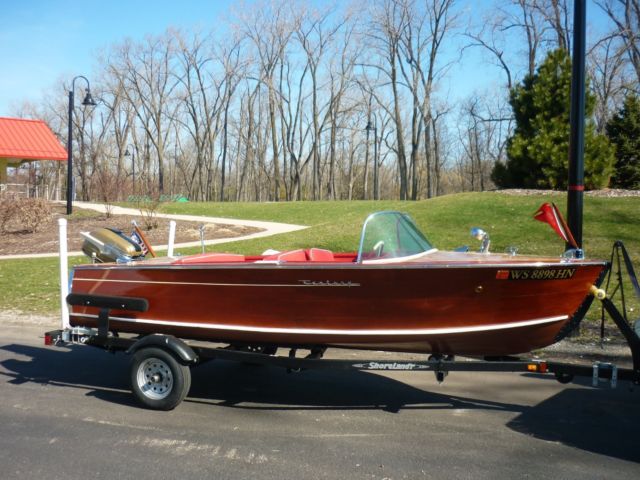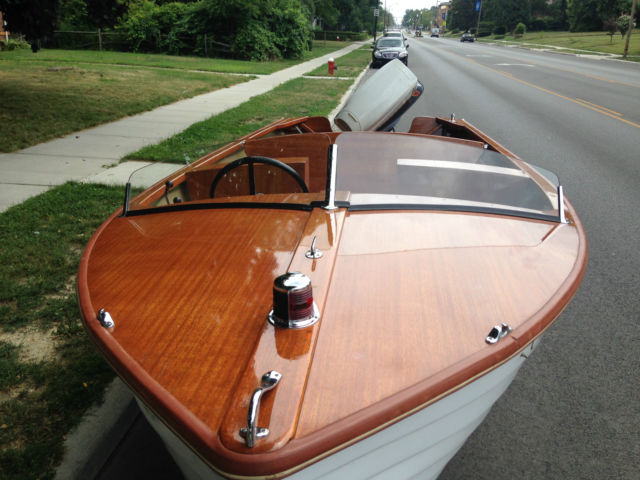

The weight difference is only a tank of gas, apart from grunting it on and off the transom for periodic transom refurbs. less relaxing and more noisy and stressful.
Wood runabout boat outboard full crack#
and had to run at full crack to get there. the perceptible difference is the 40s are 25 kgs heavier, 3 cyl instead of 2, but have a top speed, one person no dogs or camping gear of 35 kts, two stroke expensive and noisy and stinky to run, and a bit faster, the newer 4 stroke much quieter, almost half the running costs, partly because of no oil, The 30hp honda was almost as fast but had to work hard and so cost the same in gas per hour. I have run the same 5 metre runabout over 15 years with a 2 stroke 40 hp Yam, a newish 4 stroke 40 Yam, and a 30 hp 4 stroke Honda.
Wood runabout boat outboard driver#
The driver was a bit younger then and had hair.

The original 12' boat had a seconf 10hp motor added and is doing about 39mph in the photo. Hope the photo comes through as I've never use this computer setup. P1010005.jpg This boat has a 1953 Merc MK20 on the transom but it was never used because it had only been in fresh water and a Johnson 25 was actually used. Such a small boat with the driver so closely connected to the water feels pretty fast at that speed. My latest was a 13' 2" runabout with an old Johnson 25 mounted and top speed with no modifications was about 32mph. Its good to study the weight versus stated power versus displacement in making the best choice of a motor. A 25 is adequate for delivering a great speedy ride while a 30 might be a bit nicer. I expect that this boat could take a 50hp if handled safely but the extra power is just not needed for what you want. Mercury and a couple others actually had more power than they were rated at. I started messing with small outboards when the most common size motor was 10hp and the largest commonly available was 25hp. I agree with whizbang on his observations and recommendations. I see she has a new trailer, be sure the bunks carry aft past the transom a few inches. If you only seek a comfy 20 mph, a flatter wheel (prop) may be all you really need with a 20 hp. I do leaps and bounds to get my own 13', 25hp speeder to be faster than most 40/50 hp runabouts,fer instance. Simple things, well, not so simple really, like fairing the bottom, sharpening the trailing edge radius, power trim, can add 20 percent to speed as good as 10/15 more horsepower.

Lets see what the bottom sheathing is ? An old stripper should take being sheathed nicely. There is a buncha amateurish lookin stuff there,I mean corny/campy. Ī new 4 cycle 30 I think would be perfect. Modern motors are indeed heavier, but have power trim and better props. There was no 40 hp until 1956, and the shape of boats changed quickly, round bilges just about disappearing on planing boats. I've attached a few pictures, thank you in advanced for you help! Unfortunately it looks like these outboards are on back order but I want to make sure to invest in the right one. I was thinking 30-40 HP short shaft (15") but want to make sure this will get me on plane (~15-20mph) but won't be too heavy for the transom. It is 13.5' from transom to bow, transom height is 16.25" and made of mahogany and teak 4 people can easily lift it and flip it over (which we just did as I'm now working on the hull). There's no model number, or markings.I don't even know the make but I was hoping you guys could help me determine which outboard would fit best. I'm hoping to keep it as original as possible. I build furniture and have a nice woodshop so I figured I'd give the rebuild a try. It most likely hasn't seen the water in 30 years but has very little rot. I came across a 1950's wooden runabout in an old garage which I obviously had to buy on the spot. Hi Guys, I'm new to the forum and to the wooden boat world in general but very enthusiastic.


 0 kommentar(er)
0 kommentar(er)
